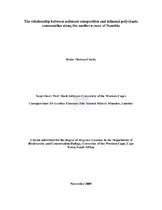| dc.description.abstract | This study examined the relationship between sediment structure and infaunal polychaete communities off the southern coast of Namibia from two separate sets of data, and a total of ninety-two samples. It also examined whether a selected group of organisms (polychaetes) could provide the same level of information regarding community structure, as the entire fauna, at a number of taxonomic resolutions. A total of 44 samples were collected by De Beers Marine (Pty) Ltd in 1999 off the southern coast of Luderitz from depths between 40 m and 90 m. The sediments varied from soft muds (45 μm) to gravel (> 710 μm). Forty-three morpho species of polychaetes were distinguished, of which only 28 known species of polychaetes could be positively identified, which suggests that more information on the diversity of polychaetes in the region is needed. The fauna was dominated by species in the Ampharetidae, Capitellidae,
Maldanidae, Spionidae, Lumbrineridae, Flabilligeridae, Nephtyidae, Pectinariidae and Onuphidae. Multi-variate analyses using PRIMER indicated that communities were
structured by mud (45 μm) and very fine sand (45 - 63 μm) and gravel (> 710 μm). Mud and gravel, although selected by the BIOENV procedure as accounting for some of the variation in the polychaete assemblage structure, explained no more of the data (in combination) than did mud on its own. As similar clustering of samples was observed when the data were analysed at both the family and species-level, suggesting that the same level of information was being gained at the two taxonomic levels. The results of the BIOENV analyses were also broadly similar for both taxonomic levels of analyses, in terms of both the proportion of the variation in assemblage structure explained by the
selected environmental variables and the choice of selected variables. These results suggested the information gathered at the polychaete family-level were equally clear when they are collected at the family-level for the entire infauna.
The use of polychaetes (to the family-level) as surrogates, using sediment structure and depth was independently investigated from a total of 48 samples that were collected by
De Beers Marine (Pty) Ltd in 2001, from depths between 20 m and 110 m. The sediment varied from mud (< 63 μm) to gravel (> 710 μm). Twenty-two families of polychaetes
were distinguished, the fauna showing an abundance of Capitellidae, Cirratulidae, Flabilligeridae, Lumbrineridae, Magelonidae, Nephtyidae, Paraonidae, Pilargiidae, Onuphidae, Syllidae and Spionidae. Striking differences were found in the amount of variation accounted for in the biological samples by the environmental data. Interestingly, depth in combination with a particular sediment size fraction featured very strongly in structuring both sets of communities. The biotic patterns in the family-level total infauna were not similar for the polychaetes (at the same taxonomic resolution). These results
suggested that one group of organisms (polychaetes at the family-level) may not be useful as a proxy for the entire infauna (at the family-level). Because of the contrasting results that were obtained in 1999 and 2001, the biological
data in 1999 were pooled and the environmental data (sediment size fractions) were adjusted accordingly (i.e. some of the differences in the results may reflect differences in the methods used to collect data). Consequently the results still did not adequately explain why there was a low level of similarity between the total infauna and polychaete
family-level biotic patterns in 2001. It seemed that pooled data improved the taxonomic resolution (amount of variation obtained), but when the sediment size fraction data were
adjusted, it lowered the amount of taxonomic resolution. The results suggest that comprehensive and standardized samples must be collected to fully understand the relationships between biotic patterns and environmental variables. This is potentially important given the costs involved and the potentially long lasting value of the material collected. These sediment and biological samples were collected by industry (for baseline biological monitoring in the mining industry, and not academic purposes). Proper protocols need to be established which allow industry-related monitoring programs to make a real contribution to our understanding of the biodiversity and ecology of the area. | en_US |

